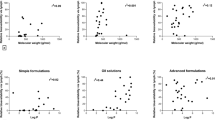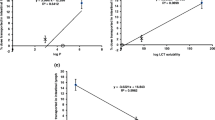ABSTRACT
Purpose
To evaluate the potential role of intestinal lymphatic transport in the absorption and oral bioavailability of members of an emerging class of anti-atherosclerosis drugs (CETP inhibitors). CP524,515 and CP532,623 are structurally related with eLogD7.4 >5; however, only CP524,515 (and not CP532,623) had sufficient solubility (>50 mg/g) in long-chain triglyceride (LCT) to be considered likely to be lymphatically transported.
Methods
CP524,515 and CP532,623 were administered intravenously and orally to fasted or fed lymph-cannulated or non-cannulated dogs. Oral bioavailability and lymphatic transport of drug (and triglyceride) was subsequently quantified.
Results
Both CETP inhibitors were substantially transported into the lymphatic system (>25% dose) in fed and fasted dogs. Food enhanced oral bioavailability (from 45 to 83% and 44 to 58% for CP524,515 and CP532,623, respectively) and the proportion of the absorbed dose transported via the lymph (from 61 to 86% and from 68 to 83%, respectively). Lymphatic triglyceride transport was significantly lower in fed dogs administered CP532,623.
Conclusion
Intestinal lymphatic transport is the major absorption pathway for CP524,515 and CP532,623, suggesting that a LCT solubility >50 mg/g is not an absolute requirement for lymphatic transport. The effect of CP532,623 on intestinal lipid transport may suggest a role in the activity/toxicity profiles of CETP inhibitors.






Similar content being viewed by others
Abbreviations
- CETP:
-
cholesterol ester transfer protein
- CM:
-
chylomicron
- HDL:
-
high density lipoprotein
- MTP:
-
microsomal TG transfer protein
- PLTP:
-
phospholipid transfer protein
- SMEDDS:
-
self micro-emulsifying drug delivery system
- TBME:
-
tert-butyl methyl ether
- TG:
-
triglyceride
- VLDL:
-
very low density lipoprotein
- LCT:
-
long chain triglyceride
REFERENCES
Shah PK. Inhibition of CETP as a novel therapeutic strategy for reducing the risk of atherosclerotic disease. Eur Heart J. 2007;28:5–12.
El Harchaoui K, van der Steeg WA, Stroes ES, Kastelein JJ. The role of CETP inhibition in dyslipidemia. Curr Atheroscler Rep. 2007;9:125–33.
Boekholdt SM, Kuivenhoven JA, Hovingh GK, Jukema JW, Kastelein JJ, van Tol A. CETP gene variation: relation to lipid parameters and cardiovascular risk. Curr Opin Lipidol. 2004;15:393–8.
Thompson A, Di Angelantonio E, Sarwar N, Erqou S, Saleheen D, Dullaart RP, et al. Association of cholesteryl ester transfer protein genotypes with CETP mass and activity, lipid levels, and coronary risk. JAMA 2008;299:2777–88.
de Grooth GJ, Kuivenhoven JA, Stalenhoef AF, de Graaf J, Zwinderman AH, Posma JL, et al. Efficacy and safety of a novel cholesteryl ester transfer protein inhibitor, JTT-705, in humans: a randomized phase II dose-response study. Circulation 2002;105:2159–65.
Klerkx AH, El Harchaoui K, van der Steeg WA, Boekholdt SM, Stroes ES, Kastelein JJ, et al. Cholesteryl ester transfer protein (CETP) inhibition beyond raising high-density lipoprotein cholesterol levels: pathways by which modulation of CETP activity may alter atherogenesis. Arterioscler Thromb Vasc Biol. 2006;26:706–15.
Kuivenhoven JA, de Grooth GJ, Kawamura H, Klerkx AH, Wilhelm F, Trip MD, et al. Effectiveness of inhibition of cholesteryl ester transfer protein by JTT-705 in combination with pravastatin in type II dyslipidemia. Am J Cardiol. 2005;95:1085–8.
Howes LG, Kostner K. The withdrawal of torcetrapib from drug development: implications for the future of drugs that alter HDL metabolism. Expert Opin Investig Drugs. 2007;16:1509–16.
Blasi E, Bamberger M, Knight D, Engwall M, Wolk R, Winter S, et al. Effects of CP-532, 623 and torcetrapib, cholesteryl ester transfer protein inhibitors, on arterial blood pressure. J Cardiovasc Pharmacol. 2009;53:507–16.
Clark RW, Ruggeri RB, Cunningham D, Bamberger MJ. Description of the torcetrapib series of cholesteryl ester transfer protein inhibitors, including mechanism of action. J Lipid Res. 2006;47:537–52.
Porter CJ, Trevaskis NL, Charman WN. Lipids and lipid-based formulations: optimizing the oral delivery of lipophilic drugs. Nat Rev Drug Discov. 2007;6:231–48.
Pouton CW, Porter CJ. Formulation of lipid-based delivery systems for oral administration: materials, methods and strategies. Adv Drug Deliv Rev. 2008;60:625–37.
Pouton CW. Formulation of poorly water-soluble drugs for oral administration: physicochemical and physiological issues and the lipid formulation classification system. Eur J Pharm Sci. 2006;29:278–87.
Serajuddin AT. Solid dispersion of poorly water-soluble drugs: early promises, subsequent problems, and recent breakthroughs. J Pharm Sci. 1999;88:1058–66.
Trevaskis NL, Charman WN, Porter CJ. Lipid-based delivery systems and intestinal lymphatic drug transport: a mechanistic update. Adv Drug Deliv Rev. 2008;60:702–16.
Khoo S, Edwards GA, Porter CJH, Charman WN. A conscious dog model for assessing the absorption, enterocyte-based metabolism, and intestinal lymphatic transport of halofantrine. J Pharm Sci. 2001;90:1599–607.
Khoo SM, Shackleford DM, Porter CJ, Edwards GA, Charman WN. Intestinal lymphatic transport of halofantrine occurs after oral administration of a unit-dose lipid-based formulation to fasted dogs. Pharm Res. 2003;20:1460–5.
Phan CT, Tso P. Intestinal lipid absorption and transport. Front Biosci. 2001;6:D299–319.
Charman WN, Stella VJ. Estimating the maximum potential for intestinal lymphatic transport of lipophilic drug molecules. Int J Pharm. 1986;34:175–8.
Holm R, Hoest J. Successful in silico predicting of intestinal lymphatic transfer. Int J Pharm. 2004;272:189–93.
Gershkovich P, Hoffman A. Uptake of lipophilic drugs by plasma derived isolated chylomicrons: linear correlation with intestinal lymphatic bioavailability. Eur J Pharm Sci. 2005;26:394–404.
Gershkovich P, Fanous J, Qadri B, Yacovan A, Amselem S, Hoffman A. The role of molecular physicochemical properties and apolipoproteins in association of drugs with triglyceride-rich lipoproteins: in-silico prediction of uptake by chylomicrons. J Pharm Pharmacol. 2009;61:31–9.
Wasan KM, Brocks DR, Lee SD, Sachs-Barrable K, Thornton SJ. Impact of lipoproteins on the biological activity and disposition of hydrophobic drugs: implications for drug discovery. Nat Rev Drug Discov. 2008;7:84–99.
Porter CJH, Charman WN. Intestinal lymphatic transport: an update. Adv Drug Deliv Rev. 2001;50:61–80.
Lombardo F, Shalaeva MY, Tupper KA, Gao F. ElogD(oct): a tool for lipophilicity determination in drug discovery. 2. Basic and neutral compounds. J Med Chem. 2001;44:2490–7.
Donovan SF, Pescatore MC. Method for measuring the logarithm of the octanol-water partition coefficient by using short octadecyl-poly(vinyl alcohol) high-performance liquid chromatography columns. J Chromatogr A. 2002;952:47–61.
Edwards GA, Porter CJ, Caliph SM, Khoo SM, Charman WN. Animal models for the study of intestinal lymphatic drug transport. Adv Drug Deliv Rev. 2001;50:45–60.
Shackleford DM, Faassen WA, Houwing N, Lass H, Edwards GA, Porter CJ, et al. Contribution of lymphatically transported testosterone undecanoate to the systemic exposure of testosterone after oral administration of two andriol formulations in conscious lymph duct-cannulated dogs. J Pharmacol Exp Ther. 2003;306:925–33.
Rane SS, Anderson BD. What determines drug solubility in lipid vehicles: is it predictable? Adv Drug Deliv Rev. 2008;60:638–56.
Lipinski CA. Drug-like properties and the causes of poor solubility and poor permeability. J Pharmacol Toxicol Methods. 2000;44:235–49.
Khoo S, Humberstone AJ, Porter CJH, Edwards GA, Charman WN. Formulation design and bioavailability assessment of lipidic self-emulsifying formulations of halofantrine. Int J Pharm. 1998;167:155–64.
Porter CJ, Kaukonen AM, Boyd BJ, Edwards GA, Charman WN. Susceptibility to lipase-mediated digestion reduces the oral bioavailability of danazol after administration as a medium-chain lipid-based microemulsion formulation. Pharm Res. 2004;21:1405–12.
Grove M, Nielsen JL, Pedersen GP, Mullertz A. Bioavailability of seocalcitol IV: evaluation of lymphatic transport in conscious rats. Pharm Res. 2006;23:2681–8.
Griffin BT, O’Driscoll CM. A comparison of intestinal lymphatic transport and systemic bioavailability of saquinavir from three lipid-based formulations in the anaesthetised rat model. J Pharm Pharmacol. 2006;58:917–25.
Gershkovich P, Qadri B, Yacovan A, Amselem S, Hoffman A. Different impacts of intestinal lymphatic transport on the oral bioavailability of structurally similar synthetic lipophilic cannabinoids: dexanabinol and PRS-211, 220. Eur J Pharm Sci. 2007;31:298–305.
Charman WN, Stella VJ. Lymphatic transport of drugs. Boca Raton: CRC; 1992.
Trevaskis NL, Porter CJ, Charman WN. The lymph lipid precursor pool is a key determinant of intestinal lymphatic drug transport. J Pharmacol Exp Ther. 2006;316:881–91.
Inazu A, Nakajima K, Nakano T, Niimi M, Kawashiri MA, Nohara A, et al. Decreased post-prandial triglyceride response and diminished remnant lipoprotein formation in cholesteryl ester transfer protein (CETP) deficiency. Atherosclerosis 2008;196:953–7.
Guerin M, Le Goff W, Duchene E, Julia Z, Nguyen T, Thuren T, et al. Inhibition of CETP by torcetrapib attenuates the atherogenicity of postprandial TG-rich lipoproteins in type IIB hyperlipidemia. Arterioscler Thromb Vasc Biol. 2008;28:148–54.
Millar JS, Brousseau ME, Diffenderfer MR, Barrett PH, Welty FK, Faruqi A, et al. Effects of the cholesteryl ester transfer protein inhibitor torcetrapib on apolipoprotein B100 metabolism in humans. Arterioscler Thromb Vasc Biol. 2006;26:1350–6.
Guyard-Dangremont V, Desrumaux C, Gambert P, Lallemant C, Lagrost L. Phospholipid and cholesteryl ester transfer activities in plasma from 14 vertebrate species. Relation to atherogenesis susceptibility. Comp Biochem Physiol B Biochem Mol Biol. 1998;120:517–25.
Tsutsumi K, Hagi A, Inoue Y. The relationship between plasma high density lipoprotein cholesterol levels and cholesteryl ester transfer protein activity in six species of healthy experimental animals. Biol Pharm Bull. 2001;24:579–81.
Tall AR. Plasma cholesteryl ester transfer protein. J Lipid Res. 1993;34:1255–74.
Alonso AL, Zentella-Dehesa A, Mas-Oliva J. Characterization of a naturally occurring new version of the cholesterol ester transfer protein (CETP) from small intestine. Mol Cell Biochem. 2003;245:173–82.
Hussain MM. A proposed model for the assembly of chylomicrons. Atherosclerosis 2000;148:1–15.
Hussain MM, Shi J, Dreizen P. Microsomal triglyceride transfer protein and its role in apoB-lipoprotein assembly. J Lipid Res. 2003;44:22–32.
Cartwright IJ, Plonne D, Higgins JA. Intracellular events in the assembly of chylomicrons in rabbit enterocytes. J Lipid Res. 2000;41:1728–39.
Beamer LJ. Structure of human BPI (bactericidal/permeability-increasing protein) and implications for related proteins. Biochem Soc Trans. 2003;31:791–4.
Beamer LJ, Fischer D, Eisenberg D. Detecting distant relatives of mammalian LPS-binding and lipid transport proteins. Protein Sci. 1998;7:1643–6.
Qiu X, Mistry A, Ammirati MJ, Chrunyk BA, Clark RW, Cong Y, et al. Crystal structure of cholesteryl ester transfer protein reveals a long tunnel and four bound lipid molecules. Nat Struct Mol Biol. 2007;14:106–13.
Jiang XC, Li Z, Liu R, Yang XP, Pan M, Lagrost L, et al. Phospholipid transfer protein deficiency impairs apolipoprotein-B secretion from hepatocytes by stimulating a proteolytic pathway through a relative deficiency of vitamin E and an increase in intracellular oxidants. J Biol Chem. 2005;280:18336–40.
Lie J, de Crom R, van Gent T, van Haperen R, Scheek L, Lankhuizen I, et al. Elevation of plasma phospholipid transfer protein in transgenic mice increases VLDL secretion. J Lipid Res. 2002;43:1875–80.
ACKNOWLEDGEMENTS
The authors thank Pfizer Global Research and Development (Groton, CT) for financial support and Michael Campbell and Daniel Gregg from the Centre for Drug Candidate Optimisation (CDCO), Monash Institute of Pharmaceutical Sciences, Parkville, Australia for the determination of Elog D.
Author information
Authors and Affiliations
Corresponding author
Rights and permissions
About this article
Cite this article
Trevaskis, N.L., McEvoy, C.L., McIntosh, M.P. et al. The Role of the Intestinal Lymphatics in the Absorption of Two Highly Lipophilic Cholesterol Ester Transfer Protein Inhibitors (CP524,515 and CP532,623). Pharm Res 27, 878–893 (2010). https://doi.org/10.1007/s11095-010-0083-0
Received:
Accepted:
Published:
Issue Date:
DOI: https://doi.org/10.1007/s11095-010-0083-0




